As regular readers know, I love fog. It’s a little like snow in the way it can transform an ordinary landscape into something dreamlike.
We’ve had a lot of interesting fog around here lately. Last week the fog was very dense in the Central Valley, sometimes persisting all day rather than burning off in the afternoon. One morning we made an early trip into the lower foothills of Mariposa County, an area with rolling, grassy hills and scattered oaks (I’ve posted images from there before). I was hoping that the fog would be thick enough to push up from the Central Valley into these foothills, and it was – just barely. We were right on the edge of the fog, which was actually perfect – foggy enough to create a misty, ethereal mood, but not so foggy that it completely obscured the landscape.
I started off working with the monochrome patterns of the oaks and hills. Then the orange ball of the sun appeared through the mist, and I raced around trying to juxtapose that sun with individual trees or groups of trees.
Most of these compositions were made from elevated vantage points. I climbed several hillsides to get better spacing and separation between foreground and background trees. Here are a couple of examples to show what I’m talking about. The first has decent left-to-right separation between the three most prominent trees, but they merge with other trees behind them:
Realizing this problem, I climbed the hill behind me, seeking a higher angle of view. This elevated perch “raised” the background oaks relative to the ones in the foreground, enabling me to get almost complete separation between all of them. And as a bonus, we see some nice spacing between the four layered ridges:
I’ve written before about the advantages of high viewpoints in this post about creating depth. If you’re trying to create a sense of depth with a normal or telephoto lens, or even a moderate wide-angle, gaining elevation helps by visually separating the foreground, middle ground, and background, which makes perspective lines and size comparisons more apparent. While there are no perspective lines in these foggy images of oaks, and it might be stretching things to say that any of the photographs have a foreground, middle ground, and background, there are some size comparisons – trees getting smaller in the distance. And there are certainly some strong atmospheric effects. So even though all of these photographs were made with telephoto lenses (my 70-200 zoom), most have them have some sense of depth.
Then again, as I’ve said before, creating depth isn’t an end in itself. The most eye-catcihng photograph of this group might be the simple, graphic image at the top of this post. It has little sense of depth, but I hope it conveys some mood, and that’s the most important thing to me.
I’d love to know what your favorites are. If any of these images stand out to you, please post a comment and let me know.
— Michael Frye
Related Posts: Creating Depth: Beyond the Wide-Angle Formula; “Ordinary” Landscapes
Did you like this article? Click here to subscribe to this blog and get every new post delivered right to your inbox!
Michael Frye is a professional photographer specializing in landscapes and nature. He is the author or principal photographer of The Photographer’s Guide to Yosemite, Yosemite Meditations, Yosemite Meditations for Women, Yosemite Meditations for Adventurers, and Digital Landscape Photography: In the Footsteps of Ansel Adams and the Great Masters. He has also written three eBooks: Light & Land: Landscapes in the Digital Darkroom, Exposure for Outdoor Photography, and Landscapes in Lightroom 5: The Essential Step-by-Step Guide. Michael has written numerous magazine articles on the art and technique of photography, and his images have been published in over thirty countries around the world. Michael has lived either in or near Yosemite National Park since 1983, currently residing just outside the park in Mariposa, California.

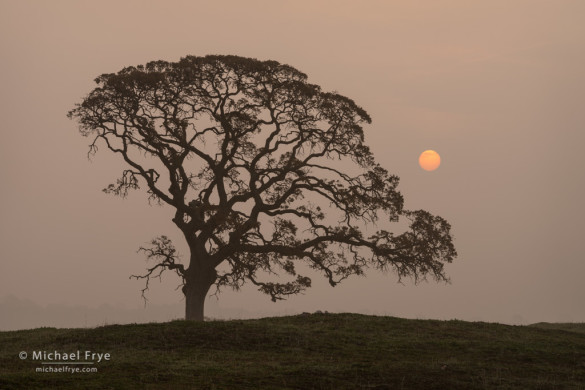
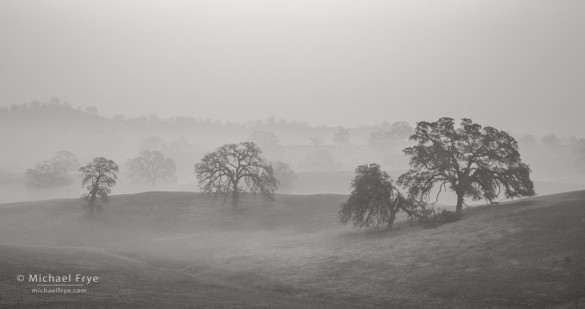
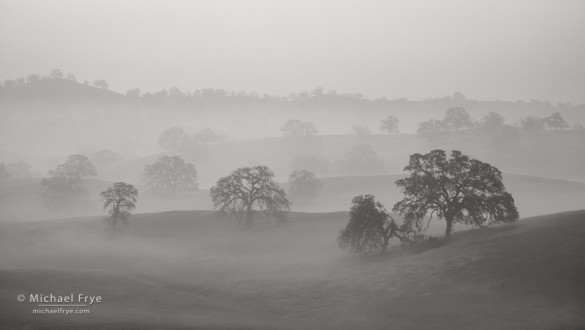
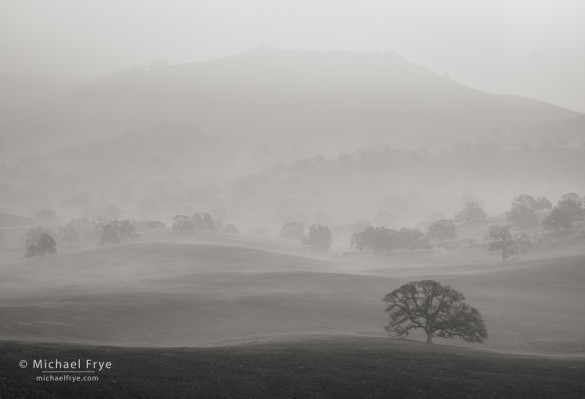
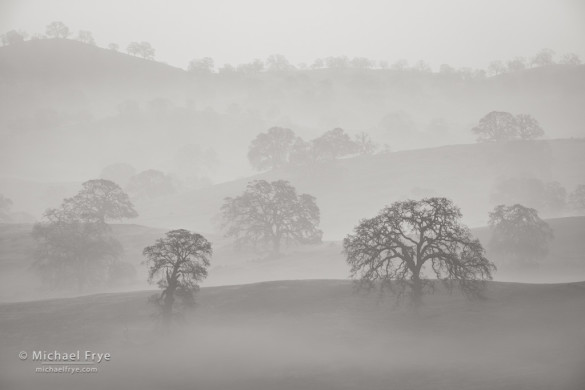
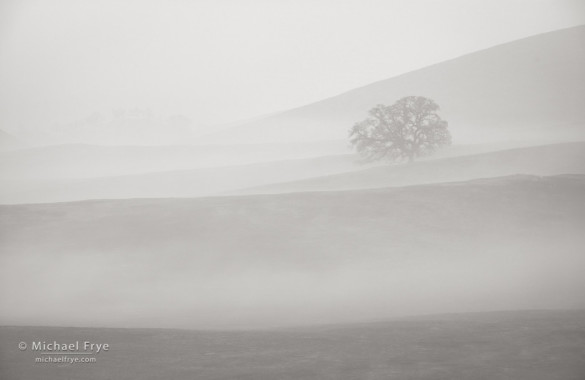
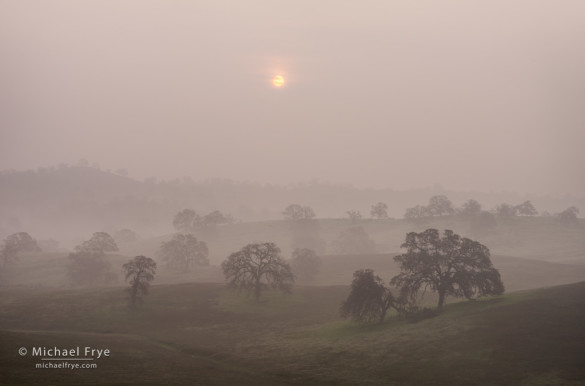








I like them all but my favorite is the first one with single tree and sun and fog. It is simple and doesn’t need depth. I think that we tend to add more elements to our photos and that distracts viewers. My motto is “keep it simple”. Thanks for sharing.
Thanks Karl!
Thank you for sharing your thoughts, experience, and images! I might be alone on this one but I love the lone tree in “Blue Oak in Fog”, and “Fogscape” a close second. Then there is the “Blue Oaks and Misty Ridges”….heck they are all great.
Thank you Lisa!
As usual, Michael, they’re all great and very difficult to pick a favorite. Oh well, here goes.
Blue Oaks and Misty Ridges spoken to me more than the others. I love the separation of the ridges as well as the trees. I could imagine myself walking up and down the hills through the trees. Then, of course, Oak, Sun and Fog expresses a oneness with nature for me.
Thanks for sharing!
Thanks for letting me know Gail!
I love the simplicity and color of Oak, Sun and Fog and the simplicity and lines of Blue Oak in Fog. Thanks for your informative post.
Thank you Hadley!
I’m attracted to the image “Blue Oaks and Misty Ridges.” You’ve used the fog to soften the transition from ridge to ridge. In all the images, the for adds a strong sense of tranquility. Thanks for sharing.
Thanks – I’m glad you like that one Frank!
I usually lean towards the simplistic image but I really like the Blue Oak Woodland in fog. I like it because of the layers. Seems more moody to me. The other one I like is the simple Oak, sun and fog at the top. The color enhances it and I love the tree.
Thanks for chiming in Nancy!
I like Blue Oak Woodland and Fog, then Fogscape, for this reason: there is a sense of balance between sky (background) and earth (foreground) areas or weight, with the nether range of fog-blended uncertainty in between them. I also like the first image – Oak, Sun, and Fog, SIerra Nevada Foothills.
Thanks very much Barbara! I appreciate you chiming in.
I keep going back to the Blue Oaks and Misty Ridges, so I would say that one is my favorite although I love the first one also, it’s very graphically pleasing. I really like images with trees so they all pretty much have my love.
Thanks very much Sharon!
Michael,
The first one is my choice, “Oak, sun and fog”. Not only is it the simplicity of the image that gets my attention but also the feeling that the bare branches of the winter tree seem to be reaching toward the sun as if they are pleading for a warm covering of leaves.
Jim
Jim, thanks for the detailed description of what you like about the image. I big part of our reactions to photographs lies in our own personal experiences, and sometimes an image evokes a feeling or memory from those experiences.
I love the first one for showing warm hope emerging from what would have been a rather subdued scene before the sun partially broke through.
I love the last one for its ethereal timeless quality and depth of somewhat mystical patterns. All of them express a beauty that almost begs for being captured.
Thank you Ralph!
My favorite shot is “Blue Oak in Fog” Simple and elemental. Shows layers and has a sense of negative space. Second would be the lead shot of of the oak, sun and fog.
Thanks Tami!
I love to photograph in fog. It creates a wonderful mood, but it also helps to isolate the primary subject. I enjoyed all of the photographs, so to rank each was a challenge. I would probably put the two images with the single tree at the top of the list. Those two, “Oak, Sun, & Fog” and “Blue Oak in Fog” have a clear primary subject with interesting secondary places for the eye to explore. I also see your point about how a higher perspective gives the hills better separation.
Studying the images longer, I’ve decided “Blue Oak in Fog” is my favorite. I like how I’m drawn to the single tree through the hillsides, but then allowed to drift off to the left with a sense of “I wonder what else is out there.” It makes me want to take a walk and explore.
Thanks for sharing your thoughts Alan!
Just wanted to say how much I enjoy all your blogs. This one in particular is one of my favorites. Like you, I just love the ethereal effect of fog and the separation fog permits. All these images are wonderful, but I think my favorite is the second to last one – the minimilist effect together with the gentle curves of the hills is beautiful! Thanks.
Thanks very much Geoff!
I am drawn to Fogscape for a few reasons, the first being the memories it brings back from when I lived in the foothills below Kings Canyon National Park. So many times driving down to the valley I would be able to enjoy images like this. This image seems to call to me, from the lone oak in the foreground to the wispiness of the rolling hills with the fog lightly settling in as it draws me up the hillside. Happily I am heading home to visit in 2 weeks, which always includes a few drives through the hills and mountains. Thank you, Michael, for bringing back some great memories.
You’re welcome Lisa, and thanks very much for your comments. I’m glad you had the chance to become intimately acquainted with the beautiful Sierra foothills.
I love photographing oak trees in the fog! Really like the set you posted. My favorites are the first one, “Oak, sun, and fog” and the “Blue Oaks and Misty Ridges” the best. Love the detail and contrast of the oak branches against the fog in the first one. Like the repetitive rows of oaks and ridges with fog ambiance in the other one. I always chuckle to myself when shooting in very foggy conditions like this about how much my very sharp zeiss lenses are not needed. 🙂
Thanks Wayne, and I’m glad you’ve enjoyed photographing foggy oaks as well. But you really do need your sharp Zeiss lenses for photographing trees in the fog. Fog softens contrast, but does not blur fine details. In these images, I can zoom in to 1:1 and see every little twig on every tree, thanks to the high resolution of the Sony A7r sensor, and the sharp copy of a Canon 70-200 f/4 zoom I used.
Yes, I agree for shots like “Oak, Sun, & Fog” where you have captured every detail of that Oak which is close and the fog is not as thick. But a shot like “Blue Oak in Fog” which has heavy fog, you think the extra lens sharpness will matter? By the way, I am starting to like that image very much too as I like the subtle transitions of the fog and the hills. Also, do you have a general set of usual LR processing settings for foggy low contrast landscapes?
Wayne, yes, absolutely, lens sharpness matters for an image like “Blue oak in fog.” Here a 1:1 view of the trees on the farthest ridge in “Blue oaks and misty ridges:”
https://www.michaelfrye.com/?attachment_id=7227
Fog softens contrast, it doesn’t blur detail. Try zooming in on your own photos of foggy trees.
Ok, I can see now from your 1:1 view of the far trees. Thanks for showing that.
We often complain about our nasty, often dangerous, pea soup Tule Fog. Thanks for capturing such landscape beauty we often overlook. (I’ll be taking the Bald Eagle Tour early tomorrow on Millerton Lake and hope the fog lifts!)
Well as you can tell, I never complain about fog. 🙂 But then I don’t have to live in it during the winter. Hope you see some eagles!
Don’t normally have to deal with fog in our lower foothills but the Millerton Lake area remained so dense that they eventually cancelled the lake tour. Will have to capture Bald Eagle photos on another day…
Well better luck next time. You should get out and photograph the fog! 🙂
Great illustration of the concept of creating depth with the two Blue Oaks photos. And the second of those is my favorite among the images in this post.
Thanks Greg!
I am always such a sucker when it comes to foggy images, and your series does not disappoint! Thank you for showing the differences between the two vantage points for “Blue oaks in fog” and “Blue oak woodland in fog.” But I think my favorite is “Blue oak in fog.” The single oak and layers of hills are lovely.
I guess I’m a sucker for foggy images too – which is why I keep looking for them. But I also enjoy viewing other people’s fog images. Anyway, thanks Vivienne!
They are all great images and difficult to pick one out. I think monochrome works best to convey the atmosphere of the time. My favorite is image no 4 with the lone oak in the foreground, it has a great sense of depth which is layered beautifully, but an overall air of simplicity. I think this demonstrates just how wonderful nature is. Surely that is what we all strive to convey in our images.
Thanks for the inspiration to want to get out there and photograph more. Simon
Thanks for sharing your thoughts about these images Simon!